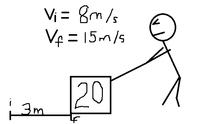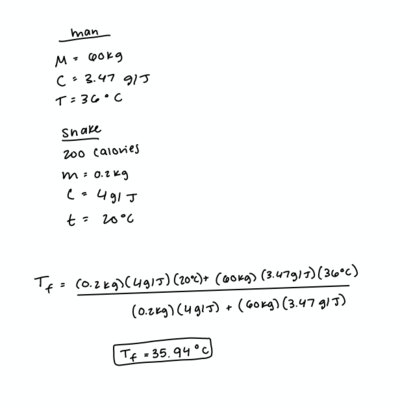Internal Energy: Difference between revisions
Mmcintire8 (talk | contribs) |
Parkercoye (talk | contribs) (→Simple) |
||
| (12 intermediate revisions by the same user not shown) | |||
| Line 1: | Line 1: | ||
==Main Idea== | ==Main Idea== | ||
Internal Energy, | Internal Energy, simply put, is energy within a system. When determining the specifics of internal energy it is best to refer to the real system of the interaction, rather than the point-particle system. The system may consist of internal interactions, such as spring interactions and thermal energy transfer. Internal Energy is any energy in the system other than movement of the center of mass. | ||
'''Internal Energy is fundamentally Potential Energy, Kinetic Energy, and Rest Energy. Broken down, this includes but is not limited to: | '''Internal Energy''' is fundamentally Potential Energy, Kinetic Energy, and Rest Energy. Broken down, this includes but is not limited to: | ||
Vibrational Energy: The potential energy of macroscopic springs cannot be modeled as a point particle system, and is often used to represent bonds between atoms in different materials. | '''Vibrational Energy''': The potential energy of macroscopic springs cannot be modeled as a point particle system, and is often used to represent bonds between atoms in different materials. | ||
Thermal Energy: Thermal Energy is any | '''Thermal Energy''': Thermal Energy is any | ||
energy in the form of heat, or changes in energy from heat transfer. | energy in the form of heat, or changes in energy from heat transfer. | ||
Rotational Energy: Rotational energy is energy of real system about the center of mass | '''Rotational Energy''': Rotational energy is energy of real system about the center of mass. | ||
'''Chemical Energy''': When a person runs, the change in kinetic energy of the runner is often affiliated with a loss in chemical energy. | |||
| Line 27: | Line 25: | ||
Determining change in Internal Energy from Change in Kinetic Energy. | Determining change in Internal Energy from Change in Kinetic Energy. | ||
'''E'''internal= '''E'''thermal+'''E''' | '''E'''<sub>internal</sub>= '''E'''<sub>thermal</sub>+'''E'''<sub>rotationa</sub>l+'''E'''<sub>vibrationa</sub>l+'''E'''<sub>chemical</sub>+... | ||
Because Energy is conserved if change in total Energy is 0, then: | Because Energy is conserved if change in total Energy is 0, then: | ||
'''KE'''i + '''E'''internal= '''KE'''f + '''E'''internal | '''KE'''<sub>i</sub> + '''E'''<sub>internal</sub>= '''KE'''<sub>f</sub> + '''E'''<sub>internal</sub> | ||
Thus, | Thus, | ||
Δ '''E'''<sub>internal </sub> = -Δ '''KE''' | |||
==Examples== | ==Examples== | ||
===Simple=== | ===Simple=== | ||
A man of mass 60kg consumes a 200 calorie protein shake of mass .2 kg, specific heat 4g/J, and temperature 20 degrees Celsius. (The average human Temperature is 36 degrees Celsius and has specific heat 3.47 g/J). The man chugs the protein shake. Determine the final temperature of the man after drinking the shake. | A man of mass 60kg consumes a 200 calorie protein shake of mass .2 kg, specific heat 4g/J, and temperature 20 degrees Celsius. (The average human Temperature is 36 degrees Celsius and has specific heat 3.47 g/J). The man chugs the protein shake. Determine the final temperature of the man after drinking the shake. | ||
| Line 53: | Line 51: | ||
3) Plug in variables and solve. | 3) Plug in variables and solve. | ||
[[File:finaltempproblem.png|400px]] | |||
===Middling=== | ===Middling=== | ||
You're pulling a block of mass 20kg across a low-friction floor. While pulling the block you notice the speed of the block has changed from 8m/s to 15 m/s. What was the change in your internal energy over this period of time? | You're pulling a block of mass 20kg across a low-friction floor. While pulling the block you notice the speed of the block has changed from 8m/s to 15 m/s. What was the change in your internal energy over this period of time? | ||
1) Diagram.[[File:Internalenergy.png]] | 1) Diagram<br>.[[File:Internalenergy.png|200px]] <br> | ||
2)Pick your system. (The block). The change in overall energy of the block is equal to the change in kinetic energy: '''KE'''f-'''KE'''i | 2)Pick your system. (The block). The change in overall energy of the block is equal to the change in kinetic energy: '''KE'''f-'''KE'''i <br> | ||
Change in KE= 1/2*20kg*(15^2-8^2)=1610 Joules | Change in KE= 1/2*20kg*(15^2-8^2)=1610 Joules | ||
3)Now consider your system to be you, the earth, and the block. Are there any outside forces acting on the system? No. Thus, Change in total energy must be 0. | 3)Now consider your system to be you, the earth, and the block. Are there any outside forces acting on the system?<br> No. Thus, Change in total energy must be 0. | ||
4)Total Energy= KE+ PE(grav) + Einternal. Since PE(grav) is 0 throughout the interaction and change in total energy is 0, negative change in KE must be equal to your change in internal energy. | 4)Total Energy= KE+ PE(grav) + Einternal. Since PE(grav) is 0 throughout the interaction and change in total energy is 0, negative change in KE must be equal to your change in internal energy. | ||
| Line 69: | Line 69: | ||
===Difficult=== | ===Difficult=== | ||
Assume you are stranded on an island. You have built a raft with the last of your energy. You have one coconuts that will give you an estimated 200 calories of energy. (A calorie is roughly 4.2*10^3 Joules). You have started moving your 200kg raft across the low-friction sand with inital velocity 2m/s. You have calculated that in order to escape the incoming tide, your raft must be travelling at least 12m/s when it reaches the ocean. You have then calculated it will take at least 150 calories to survive the trip, and another 45 to keep your friend Wilson from drifting away during the trip (no sleeping). Do you have enough energy to save Wilson? Do you have enough energy to save yourself? | Assume you are stranded on an island. You have built a raft with the last of your energy. You have one coconuts that will give you an estimated 200 calories of energy. (A calorie is roughly 4.2*10^3 Joules). You have started moving your 200kg raft across the low-friction sand with inital velocity 2m/s. You have calculated that in order to escape the incoming tide, your raft must be travelling at least 12m/s when it reaches the ocean. You have then calculated it will take at least 150 calories to survive the trip, and another 45 to keep your friend Wilson from drifting away during the trip (no sleeping). Do you have enough energy to save Wilson? Do you have enough energy to save yourself? | ||
Note:Calories is representative of Chemical Energy, and thus find the minimum change in internal energy required to move the raft to solve this problem. | Note: Calories is representative of Chemical Energy, and thus find the minimum change in internal energy required to move the raft to solve this problem. | ||
1)Diagram | 1)Diagram <br> | ||
[[File:InternalEnergy2.png]] | [[File:InternalEnergy2.png|200px]] | ||
2)The Internal Energy required to move the raft (as in example 1) Is equal to the Change in Kinetic Energy. | 2)The Internal Energy required to move the raft (as in example 1) Is equal to the Change in Kinetic Energy. <br> | ||
Change in KE = 1/2(200kg)*(vf^2-vi^2)= 1/2*200*(15^2-2^2) | Change in KE = 1/2(200kg)*(vf^2-vi^2)= 1/2*200*(15^2-2^2) | ||
Required Internal Energy = 22,100J | Required Internal Energy = 22,100J | ||
3) Determine the Energy supplied by one coconut after taking away the calories needed to survive the trip. | 3) Determine the Energy supplied by one coconut after taking away the calories needed to survive the trip. <br> | ||
200 calories- 150 calories to survive - 45 calories for wilson = 5 calories | 200 calories- 150 calories to survive - 45 calories for wilson = 5 calories | ||
| Line 88: | Line 88: | ||
Unfortunately you have enough energy to save yourself, but your friend Wilson is doomed to travel the seas forever. | '''Unfortunately you have enough energy to save yourself, but your friend Wilson is doomed to travel the seas forever.''' | ||
==Connectedness== | ==Connectedness== | ||
| Line 99: | Line 99: | ||
Using our understanding of Internal Energy, we can minimize Energy dissipation, create better longer lasting batteries, create machines that require less power that can store more energy. Applying our understanding of Internal Energy is our best chance at creating something close to perpetual motion, and maximizing energy output of our systems. | Using our understanding of Internal Energy, we can minimize Energy dissipation, create better longer lasting batteries, create machines that require less power that can store more energy. Applying our understanding of Internal Energy is our best chance at creating something close to perpetual motion, and maximizing energy output of our systems. | ||
ADD MORE INFO ABOUT CONNECTEDNESS HERE | |||
==History== | ==History== | ||
Many scientists have contributed to our understanding of Internal Energy. From James Joule's work on thermal energy, to Albert Einstein's famous equation for rest energy. | Many scientists have contributed to our understanding of Internal Energy. From James Joule's work on thermal energy, to Albert Einstein's famous equation for rest energy. | ||
ADD MORE INFO ABOUT THE HISTORY OF INTERNAL ENERGY HERE (remember to cite your sources!!) | |||
== See also == | == See also == | ||
===External links=== | ===External links=== | ||
Latest revision as of 10:53, 29 July 2019
Main Idea
Internal Energy, simply put, is energy within a system. When determining the specifics of internal energy it is best to refer to the real system of the interaction, rather than the point-particle system. The system may consist of internal interactions, such as spring interactions and thermal energy transfer. Internal Energy is any energy in the system other than movement of the center of mass.
Internal Energy is fundamentally Potential Energy, Kinetic Energy, and Rest Energy. Broken down, this includes but is not limited to:
Vibrational Energy: The potential energy of macroscopic springs cannot be modeled as a point particle system, and is often used to represent bonds between atoms in different materials.
Thermal Energy: Thermal Energy is any
energy in the form of heat, or changes in energy from heat transfer.
Rotational Energy: Rotational energy is energy of real system about the center of mass.
Chemical Energy: When a person runs, the change in kinetic energy of the runner is often affiliated with a loss in chemical energy.
A Mathematical Model
Determining change in Internal Energy from Change in Kinetic Energy.
Einternal= Ethermal+Erotational+Evibrational+Echemical+...
Because Energy is conserved if change in total Energy is 0, then:
KEi + Einternal= KEf + Einternal
Thus,
Δ Einternal = -Δ KE
Examples
Simple
A man of mass 60kg consumes a 200 calorie protein shake of mass .2 kg, specific heat 4g/J, and temperature 20 degrees Celsius. (The average human Temperature is 36 degrees Celsius and has specific heat 3.47 g/J). The man chugs the protein shake. Determine the final temperature of the man after drinking the shake.
For future reference: m= shake mass, c=shake specific heat, t= shake initial temperature, M = man mass, C= man specific heat, T= man initial temperature.
1) Because thermal energy is conserved,
m*c*t + M*C*T = m*c*Tfinal +M*C*Tfinal
2)Solve for Tfinal
Tfinal= (m*c*t + M*C*T)/ (m*c + M*C)
3) Plug in variables and solve.
Middling
You're pulling a block of mass 20kg across a low-friction floor. While pulling the block you notice the speed of the block has changed from 8m/s to 15 m/s. What was the change in your internal energy over this period of time?
1) Diagram
.
2)Pick your system. (The block). The change in overall energy of the block is equal to the change in kinetic energy: KEf-KEi
Change in KE= 1/2*20kg*(15^2-8^2)=1610 Joules
3)Now consider your system to be you, the earth, and the block. Are there any outside forces acting on the system?
No. Thus, Change in total energy must be 0.
4)Total Energy= KE+ PE(grav) + Einternal. Since PE(grav) is 0 throughout the interaction and change in total energy is 0, negative change in KE must be equal to your change in internal energy.
Change in your Internal Energy (assuming high efficiency and no energy lost to surroundings) = 1610 Joules
Difficult
Assume you are stranded on an island. You have built a raft with the last of your energy. You have one coconuts that will give you an estimated 200 calories of energy. (A calorie is roughly 4.2*10^3 Joules). You have started moving your 200kg raft across the low-friction sand with inital velocity 2m/s. You have calculated that in order to escape the incoming tide, your raft must be travelling at least 12m/s when it reaches the ocean. You have then calculated it will take at least 150 calories to survive the trip, and another 45 to keep your friend Wilson from drifting away during the trip (no sleeping). Do you have enough energy to save Wilson? Do you have enough energy to save yourself?
Note: Calories is representative of Chemical Energy, and thus find the minimum change in internal energy required to move the raft to solve this problem.
2)The Internal Energy required to move the raft (as in example 1) Is equal to the Change in Kinetic Energy.
Change in KE = 1/2(200kg)*(vf^2-vi^2)= 1/2*200*(15^2-2^2) Required Internal Energy = 22,100J
3) Determine the Energy supplied by one coconut after taking away the calories needed to survive the trip.
200 calories- 150 calories to survive - 45 calories for wilson = 5 calories
5 calories/coconut x 4.2*10^3 Joules/calorie = 21,000 Joules/coconut
Unfortunately you have enough energy to save yourself, but your friend Wilson is doomed to travel the seas forever.
Connectedness
- How is this topic connected to something that you are interested in?
Internal Energy is connected to your everyday life. It fundamentally explains why one must eat (chemical energy) to move (kinetic energy). Internal Energy also describes energy dissipation, and thus is key to solving the Energy crisis.
- How is it connected to your major?
Internal Energy is extremely important to Mechanical Engineering. It explains the different manners and ways that energy can be stored within a system, and later utilized for Kinetic Energy.
- Is there an interesting industrial application?
Using our understanding of Internal Energy, we can minimize Energy dissipation, create better longer lasting batteries, create machines that require less power that can store more energy. Applying our understanding of Internal Energy is our best chance at creating something close to perpetual motion, and maximizing energy output of our systems.
ADD MORE INFO ABOUT CONNECTEDNESS HERE
History
Many scientists have contributed to our understanding of Internal Energy. From James Joule's work on thermal energy, to Albert Einstein's famous equation for rest energy. ADD MORE INFO ABOUT THE HISTORY OF INTERNAL ENERGY HERE (remember to cite your sources!!)
See also
External links
http://hyperphysics.phy-astr.gsu.edu/hbase/thermo/inteng.html
References
This section contains the the references you used while writing this page
Notes from Georgia Tech Physics 1
Matter and Interactions 4th Edition

